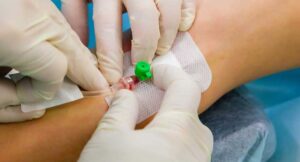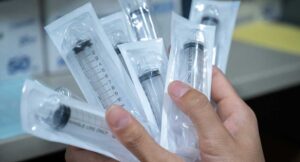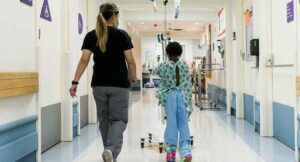The global vascular access devices market, valued at USD 5.60 billion in 2023, is forecasted to grow at a robust CAGR of 7.1%, reaching USD 5.99 billion in 2024 and an impressive USD 9.05 billion by 2030. The increasing prevalence of chronic diseases, such as cancer and chronic kidney diseases, drives market growth. Additionally, increased government support for the construction of healthcare infrastructure and technological advancements are expected to impact market growth. The increasing number of hospitals globally also poses an opportunistic factor for market growth.
Based on type, the vascular access device market is divided into central venous access device, peripheral vascular access device, intraosseous vascular access device, and accessories. Among these, in 2023, the central venous access device segment accounted for the highest market share in the vascular access device market. This is owing to increasing incidence of cancer cases and chronic diseases such as chronic kidney diseases. Additionally, increasing chemotherapy procedure fuels the market growth for vascular access devices. Central venous access devices are further divided into peripherally inserted central catheters, tunnelled catheters, non-tunnelled catheters, and implantable ports. Among these, the peripherally inserted central catheter to hold the largest market share in 2023. As peripherally inserted central catheters are less likely to pose any complications after the insertion of the device, thus majority of the times in developed regions these devices are preferred over other central venous access devices. As the prevalence of chronic diseases increases the need of central line is rising for long-term therapy, thus increasing the demand for central venous access devices across the globe. Among these, tunnelled catheters to grow at the fastest rate during forecast period. This is due to increasing prevalence of chronic kidney diseases. During haemodialysis procedure these tunnelled catheters are preferred as these are associated with less complications and can be there in the body for 3 to 6 months.
Based on route of insertion, the vascular access device market is segmented into intravenous route of insertion, subcutaneous route of insertion, and intraosseous route of insertion. Among these, the intravenous route of insertion segment accounts for the largest share of the vascular access device market in 2023. As majority of the vascular access devices such as peripherally inserted central venous catheters, tunneled catheter, non-tunneled catheters, peripheral intravenous catheter, midline catheters, winged or butterfly needles are inserted via intravenous route. As the usage of these devices is increasing due to rising prevalence of lifestyle diseases, thus contributing to the market growth. Additionally, for subcutaneous and intraosseous route of insertion the specific healthcare professionals are required for the insertion of the devices. Thus, majority of the healthcare professionals prefer the intravenous route of insertion for various applications. The subcutaneous segment to hold the second largest position, owing to increasing incidence of cancer cases across the globe.
By region, the vascular access device market is divided into 5 main regions, North America, Europe, Asia Pacific, Latin America, and Middle East & Africa. Among these regions, in 2023, the North American region holds the largest market share in the vascular access device market, owing to increasing prevalence of chronic diseases such as chronic kidney diseases, cancer, cardiovascular diseases and among others. For instance, as per National Cancer Institute, there will be 2,001,140 new cancer cases in 2024 in US. Additionally, the center for disease control and prevention stated in 2023, that more than 1 in 7 adults, (approximately 35.5 million people) are estimated to have one chronic kidney disease (CKD).
Furthermore, they stated in February 2024 that 129 million American suffer at least one major chronic disease. As these diseases require generally long-term hospitalizations, which includes intravenous medication administration, thus driving the market growth. The North American vascular access device market is divided into US, and Canada. Among these, US holds the largest market share in 2023, owing to the presence of key manufacturing players in the region is supporting the market growth. As these companies are heavily investing for research and development thus contributing to the market growth in US. Additionally in Canada the growth of the vascular access device market is due to increasing clinical trials conducted in this region. For instance, in August 2024 the phase 3 clinical trial on intranasal fentanyl in preterm infants undergoing peripherally inserted central catheter placed got completed at Mount Sinai Hospital in Canada. As the number of clinical trials increases, the demand for these devices is also rising, supporting market growth in the region. The Asia Pacific region accounted for a significant share of the global vascular access device market in 2023 and is expected to grow at the fastest CAGR during the forecast period, driven by an increasing aging population and the rising prevalence of chronic diseases. The Asia Pacific region includes Japan, China, India, Australia, South Korea, and the rest of the region. Among these, China held the largest share of the Asia Pacific vascular access device market in 2023, attributed to the country’s rapidly aging population and the growing prevalence of chronic diseases. For instance, in 2022, there were 280.04 million people aged 60 and above, with chronic diseases affecting 66.3% of older adults, including conditions like cardiovascular diseases and cancers. This growing healthcare demand is necessitating efficient vascular access devices for long-term therapies further increasing demand for vascular access devices. Additionally, the rising cancer cases and upsurging number of hospitals are contributing to the regional growth. For instance, in 2022, China recorded for 4,824,700 new cancer cases and 2,574,200 cancer-related deaths highlighting the need for intravenous treatments. Furthermore, as per CEIC data, number of hospitals in China increased to 38,4000 in 2023 up from 36,976 in 2022. Thus, increasing the demand for vascular access device continues to grow. Furthermore, India accounts for second largest share in Asia Pacific vascular access device market, owing to increasing healthcare expenditure. MarketsandMarkets









